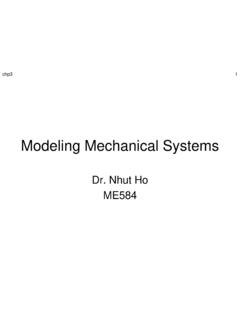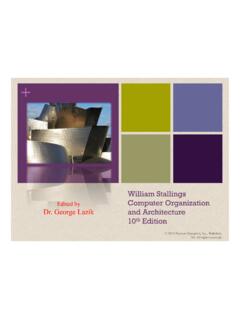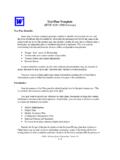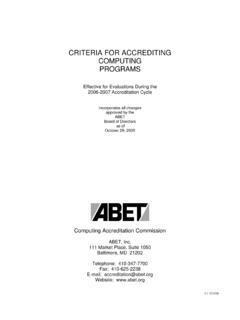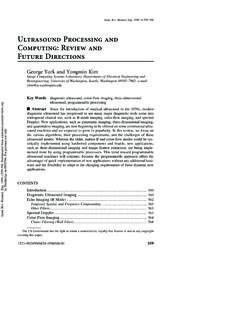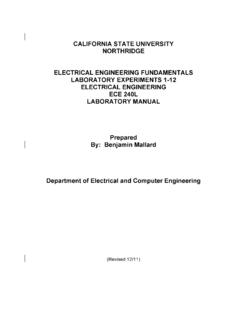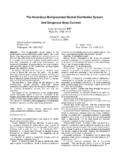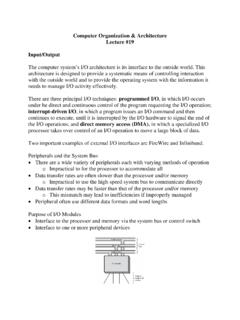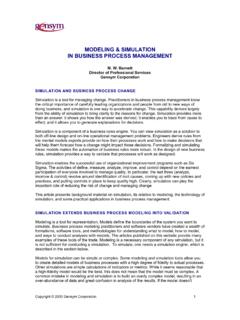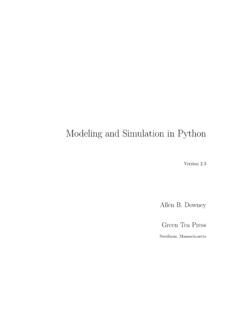Transcription of Introduction to Modeling and Simulation
1 Introduction to Modeling and Simulation Dr. Nhut HoME584 Chap11 Agenda Dynamic Systems Modeling of Dynamic Systems Introduction to Matlab Active learning: Pair-share questions, Exercises in classChap12 Dynamic SystemsChap13 Static V. Dynamic Systems Static Output does not change with time Output at any time depends on input at that time only Dynamic Output is not instantaneously proportional to input or disturbance, may continue after input held constant Present output depends on past inputsChap14 Dynamic Systems in Engineering Disciplines Mechanical systems Electrical systems Fluid systems Thermal systems Mixed systems Electro-Mechanical Fluid-Mechanical Thermo-Mechanical Electro-ThermalName an example and describe its dynamic responseChap15 Modeling What is a model? Physical models ( , scale model) Graphs or plots ( , time-dependent behavior) Mathematical models Modeling Identifying physical dynamic effects Writing differential equations using conservation and property laws Expressing in differential equations forms Chap16 Modeling of Dynamic SystemsChap17 Modeling Steps Inaccuracies propagate in each step ( , linearization, ignoring higher dynamics) Iterative modifications needed to get required output Example.
2 Modeling steps for your favorite sport deviceChap18 Representing Dynamic SystemsChap19 Mathematical Representation and Solution MethodsChap110 SystemEquations Solution MethodsClassical differential equation Analytical SolutionTransfer function Laplace TransformState space Digital/AnalogSimulationfxxx 32 )()(3)(2)(2sFsXssXssX fzxzx 102310 Model Classification TreeChap1110),,,,(222222 zTyTxTtTTf0),( tTTfModel Classification TreeChap112 Linear System Let u(t) be input and y(t) be output, the system is linear if Additivity: Response to u1+u2is y1+y2 Homogeneity: Response to au1is ay1 Example: Show that y(t) = 2x(t) + 3 is not linear If x1=2 and x2=3, then y1=2*2+3= 7, and y2=2*3+3=9 But for x3 = x1 + x2= 5, then y3=2*5+3=13 And y3 y1+ y2= 16 System is not linear Chap113 Pair-share exercise: Linear System Example Consider this system: y(t) = t u(t) Is this system is linear? Consider two arbitraryinputs u1and u2 y1= tu1 y2= tu2 Let u3= au1+ bu2, where a and b are arbitraryscalar constants y3= tu3= t (au1+ bu2) = atu1+ btu2= ay1+by2 System is linearChap114 Introduction to MatlabChap115 Outline(1)Getting Started(2)Scripts(3)Making Variables(4)Manipulating Variables(5)Basic PlottingChap116 Getting Started Open up MATLAB for Windows Through the START Menu Or Click on MatlabiconChap117 Command WindowCurrent directoryWorkspaceCommand HistoryChap118 Making Folders Use folders to keep your programs organized To make a new folder, click the Browse button next to Current Directory Click the Make New Folder button, and change the name of the folder.
3 Do NOT use spaces in folder names. In the MATLAB folder, make a new folder: ME584\MatlabIntro Highlight the folder you just made and click OK The current directory is now the folder you just created To see programs outside the current directory, they should be in the Path. Use File-> Set Path to add folders to the pathChap119 Customization File Preferences Allows you personalize your MATLAB experienceChap120 MATLAB Basics MATLAB can be thought of as a super-powerful graphing calculator Remember the TI-83 from calculus? With many more buttons (built-in functions) In addition it is a programming language MATLAB is an interpreted language, like Java Commands executed line by lineChap121 Help/Docs help The mostimportant function for learning MATLAB on your own To get info on how to use a function: help sin Help lists related functions at the bottom and links to the doc To get a nicer version of help with examples and easy-to-read descriptions: doc sin To search for a function by specifying keywords: doc + Search tabChap122 Outline(1)Getting Started(2)Scripts(3)Making Variables(4)Manipulating Variables(5)Basic PlottingChap123 Scripts: Overview Scripts are collection of commands executed in sequence written in the MATLAB editor saved as m-files (.)
4 M extension) To create an m-file from command-line edit or clickChap124 Scripts: the Editor* Means that it's not savedLine numbersCommentsm-file pathHelp filePossible breakpointsDebugging toolsReal-time error checkChap125 Scripts: Some Notes COMMENT! Anything following a %is seen as a comment The first contiguous comment becomes the script's help file Comment thoroughly to avoid wasting time later Note that scripts are somewhat static, since there is no input and no explicit output All variables created and modified in a script exist in the workspace even after it has stopped runningChap126 Exercise: ScriptsMake a helloWorldscript When run, the script should display the following text: Hint: use dispto display strings. Strings are written between single quotes, like 'This is a string'Hello World!I am going to learn MATLAB!Chap127 Exercise: ScriptsMake a helloWorldscript When run, the script should display the following text: Hint: use dispto display strings.
5 Strings are written between single quotes, like 'This is a string' Open the editor and save a script as This is an easy script, containing two lines of code: % % my first hello world program in MATLAB disp('Hello World!'); disp('I am going to learn MATLAB!');Hello World!I am going to learn MATLAB!Chap128 Outline(1)Getting Started(2)Scripts(3)Making Variables(4)Manipulating Variables(5)Basic PlottingChap129 Variable Types MATLAB is a weakly typed language No need to initialize variables! MATLAB supports various types, the most often used are 64-bit double (default) a 16-bit char Most variables you ll deal with will be vectors or matrices of doubles or chars Other types are also supported: complex, symbolic, 16-bit and 8 bit integers, etc. You will be exposed to all these types through the homeworkChap130 Naming variables To create a variable, simply assign a value to a name: var1= myString= hello world Variable names first character must be a LETTER after that, any combination of letters, numbers and _ CASE SENSITIVE!
6 (var1is different from Var1) Built-in variables. Don t use these names! iand jcan be used to indicate complex numbers pihas the value ansstores the last unassigned value (like on a calculator) Infand -Infare positive and negative infinity NaN represents Not a Number Chap131 Scalars A variable can be given a value explicitly a = 10 shows up in workspace! Or as a function of explicit values and existing variables c = *45-2*a To suppress output, end the line with a semicolon cooldude = 13/3;Chap132 Arrays Like other programming languages, arrays are an important part of MATLAB Two types of arrays(1)matrix of numbers (either double or complex)(2)cell array of objects (more advanced data structure)MATLAB makes vectors easy!That s its power!Chap133 Row Vectors Row vector: comma or space separated values between brackets row = [1 2 ] row = [1, 2, , ]; Command window: Workspace:Chap134 Column Vectors Column vector: semicolon separated values between brackets column = [4;2;7;4] Command window: Workspace:Chap135size & length You can tell the difference between a row and a column vector by: Looking in the workspace Displaying the variable in the command window Using the size function To get a vector's length, use the length functionChap136 Matrices Make matrices like vectors Element by element a= [1 2;3 4]; By concatenating vectors or matrices (dimension matters) a = [1 2]; b = [3 4]; c = [5;6]; d = [a;b]; e = [d c]; f = [[e e];[a b a]]; str = ['Hello, I am ' 'John'].
7 Strings are character vectors1234a Chap137save/clear/load Use saveto save variables to a file save myFilea b saves variables a and b to the file file is saved in the current directory Default working directory is \MATLAB Make sure you re in the desired folder when saving files. Right now, we should be in: MATLAB\ME584\MatlabIntro Use clearto remove variables from environment clear a b look at workspace, the variables a and b are gone Use loadto load variable bindings into the environment load myFile look at workspace, the variables a and b are back Can do the same for entire environment save myenv; clear all; load myenv;Chap138 Exercise: VariablesGet and save the current date and time Create a variable startusing the function clock What is the size of start? Is it a row or column? What does startcontain? See help clock Convert the vector startto a string. Use the function datestr and name the new variable startString Save startand startStringinto a mat file named startTimeChap139 Exercise: VariablesGet and save the current date and time Create a variable startusing the function clock What is the size of start?
8 Is it a row or column? What does startcontain? See help clock Convert the vector startto a string. Use the function datestr and name the new variable startString Save startand startStringinto a mat file named startTime help clock start=clock; size(start) help datestr startString=datestr(start); save startTime start startStringChap140 Exercise: VariablesRead in and display the current date and time In , read in the variables you just saved using load Display the following text: Hint: use the dispcommand again, and remember that strings are just vectors of characters so you can join two strings by making a row vector with the two strings as started learning Matlab on *start date and time*Chap141 Exercise: VariablesRead in and display the current date and time In , read in the variables you just saved using load Display the following text: Hint: use the dispcommand again, and remember that strings are just vectors of characters so you can join two strings by making a row vector with the two strings as sub-vectors.
9 Load startTime disp(['I started learning Matlab on ' .. startString]);I started learning Matlab on *start date and time*Chap142 Outline(1)Getting Started(2)Scripts(3)Making Variables(4)Manipulating Variables(5)Basic PlottingChap143 Basic Scalar Operations Arithmetic operations (+,-,*,/) 7/45 (1+i)*(2+i) 1 / 0 0 / 0 Exponentiation (^) 4^2 (3+4*j)^2 Complicated expressions, use parentheses ((2+3)*3)^ Multiplication is NOT implicit given parentheses 3(1+ ) gives an error To clear command window clcChap144 Built-in Functions MATLAB has an enormouslibrary of built-in functions Call using parentheses passing parameter to function sqrt(2) log(2), log10( ) cos( ), atan( ) exp(2+4*i) round( ), floor( ), ceil( ) angle(i); abs(1+i);Chap145 Exercise: ScalarsYou will learn MATLAB at an exponential rate! Add the following to your helloWorld script: Your learning time constant is days. Calculate the number of secondsin days and name this variable tau This class lasts 5 days.
10 Calculate the number of seconds in 5 days and name this variable endOfClass This equation describes your knowledge as a function of time t: How well will you know MATLAB at endOfClass? Name this variable knowledgeAtEnd. (use exp) Using the value of knowledgeAtEnd, display the phrase: Hint:to convert a number to a string, use num2str/1tke At the end of , I will know X% of MatlabChap146 Exercise: Scalars secPerDay=60*60*24; tau= *secPerDay; endOfClass=5*secPerDay knowledgeAtEnd=1-exp(-endOfClass/tau); disp(['At the end of , I will know ' .. num2str(knowledgeAtEnd*100) '% of Matlab'])Chap147 Transpose The transpose operators turns a column vector into a row vector and vice versa a = [1 2 3 4+i] transpose(a) a' a.' The'gives the Hermitian-transpose, transposes and conjugates all complex numbers For vectors of real numbers .'and 'give same resultChap148 Addition and Subtraction Addition and subtraction are element-wise; sizes must match (unless one is a scalar): The following would give an error c = row + column Use the transpose to make sizes compatible c = row + column c = row + column Can sum up or multiply elements of vector s=sum(row); p=prod(row); 12 3 32 112 11 30 3214 14 2 21 123911210 132303333 Chap149 Element-Wise Functions All the functions that work on scalars also work on vectors t = [1 2 3]; f = exp(t); is the same as f = [exp(1) exp(2) exp(3)]; If in doubt, check a function s help file to see if it handles vectors elementwise Operators (* / ^) have two modes of operation element-wise standardChap150 Operators: element-wise To do element-wise operations, use the dot.
